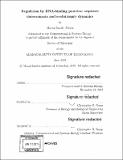| dc.contributor.advisor | Christopher B. Burge. | en_US |
| dc.contributor.author | Alexis, Maria Sarah. | en_US |
| dc.contributor.other | Massachusetts Institute of Technology. Computational and Systems Biology Program. | en_US |
| dc.date.accessioned | 2019-11-04T20:20:57Z | |
| dc.date.available | 2019-11-04T20:20:57Z | |
| dc.date.copyright | 2019 | en_US |
| dc.date.issued | 2019 | en_US |
| dc.identifier.uri | https://hdl.handle.net/1721.1/122719 | |
| dc.description | Thesis: Ph. D., Massachusetts Institute of Technology, Computational and Systems Biology Program, 2019 | en_US |
| dc.description | Cataloged from PDF version of thesis. | en_US |
| dc.description | Includes bibliographical references (pages 125-146). | en_US |
| dc.description.abstract | RNA-binding proteins (RBPs) regulate all aspects of RNA metabolism, such as splicing, localization, translation, and degradation. RNA processing is a critical component of gene expression regulation, and adaptive changes in RNA processing underlie many phenotypic differences between species. RBPs regulate RNA processing by recognizing RNA sequence elements (motifs) within RNAs. Studying the determinants of these RBP:RNA interactions is therefore key to understanding how RBPs select their targets, and how RNA processing evolves over time. This thesis presents three chapters revolving around these questions. First, I present a large-scale analysis of the evolution of gene expression across tissues, species, and studies. This study differs from previous studies in its usage of inter-sample distances to model gene expression divergence, a method that allowed us to reconcile disparate findings in the field. | en_US |
| dc.description.abstract | Second, I present a comprehensive study of the affinity landscapes of 78 human RBPs using RNA Bind-N-Seq (RBNS), an unbiased assay that determines the sequence, structure, and context preferences of RBPs. Integrated analysis of all 78 motifs reveals an unexpectedly low diversity of RNA motifs, implying frequent convergence of binding specificity towards a relatively small set of RNA motifs, many with low compositional complexity. Offsetting this trend, RBPs show extensive preferences for contextual features distinct from short linear motifs, including spaced "bipartite" motifs, biased flanking nucleotide composition, and bias away from or toward RNA structure. These results emphasize the importance of contextual features in RNA recognition, which likely enable targeting of distinct subsets of transcripts by different RBPs that recognize the same linear motif. | en_US |
| dc.description.abstract | Lastly, I compile a catalog of all known RBP specificities and examine their conservation patterns, in vivo binding patterns, and evolutionary trajectories across species. This work demonstrates that RNA regulation can be well conserved despite rapid evolution of RBP binding sites, and highlights mechanisms that may contribute to this robustness. This phenomenon is well-characterized for transcriptional regulation at promoters, but has not well been described for RNA regulation. Taken together, these studies advance our understanding of RBP target selection and how it evolves over time, thereby furthering our understanding of the basic mechanisms that govern gene regulation. | en_US |
| dc.description.statementofresponsibility | by Maria Sarah Alexis. | en_US |
| dc.format.extent | 146 pages | en_US |
| dc.language.iso | eng | en_US |
| dc.publisher | Massachusetts Institute of Technology | en_US |
| dc.rights | MIT theses are protected by copyright. They may be viewed, downloaded, or printed from this source but further reproduction or distribution in any format is prohibited without written permission. | en_US |
| dc.rights.uri | http://dspace.mit.edu/handle/1721.1/7582 | en_US |
| dc.subject | Computational and Systems Biology Program. | en_US |
| dc.title | Regulation by RNA-binding proteins : sequence determinants and evolutionary dynamics | en_US |
| dc.type | Thesis | en_US |
| dc.description.degree | Ph. D. | en_US |
| dc.contributor.department | Massachusetts Institute of Technology. Computational and Systems Biology Program | en_US |
| dc.identifier.oclc | 1124073959 | en_US |
| dc.description.collection | Ph.D. Massachusetts Institute of Technology, Computational and Systems Biology Program | en_US |
| dspace.imported | 2019-11-04T20:20:56Z | en_US |
| mit.thesis.degree | Doctoral | en_US |
| mit.thesis.department | CSB | en_US |
